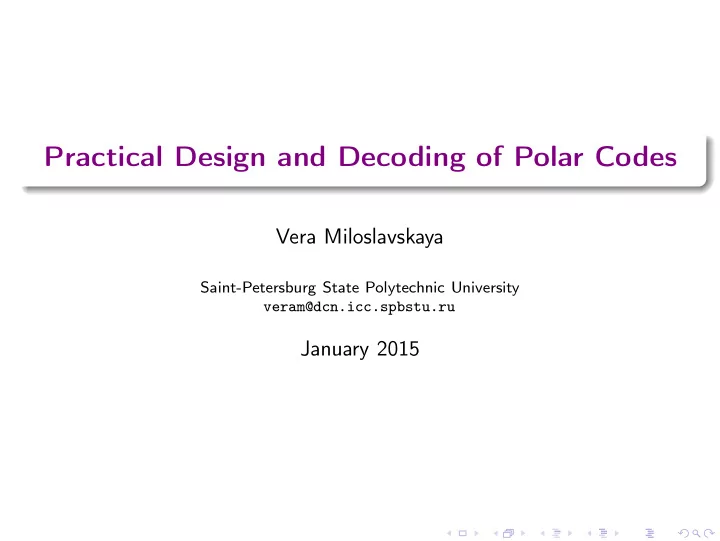

Practical Design and Decoding of Polar Codes Vera Miloslavskaya Saint-Petersburg State Polytechnic University veram@dcn.icc.spbstu.ru January 2015
Polar Codes Polar codes can achieve the capacity of 1 0 0 0 0 0 0 0 an arbitrary binary-input 1 1 0 0 0 0 0 0 output-symmetric memoryless channel 1 0 1 0 0 0 0 0 1 1 1 1 0 0 0 0 An ( n = l m , k ) polar code is generated ⊗ 3 A = 1 0 0 0 1 0 0 0 by k rows of matrix G n = A ⊗ m , where 1 1 0 0 1 1 0 0 � 1 � 0 1 0 1 0 1 0 1 0 A = 1 1 1 1 1 1 1 1 1 1 u 0 =0 c 0 Problems: u 4 =0 c 1 u 2 =0 c 2 The successive cancellation a 0 u 6 =a 0 c 3 decoder is far from maximum u 1 =0 c 4 likelihood a 1 u 5 =a 1 c 5 Minimum distance of polar code a 2 u 3 =a 2 c 6 ∼ √ n a 3 u 7 =a 3 c 7 The original Arikan construction results in codes of length 2 m Vera Miloslavskaya (SPbSPU) Practical Design and Decoding of Polar Codes January 2015 2 / 4
Design of Polar Codes A generalization of polar codes: Length=1024, Dimension=512 dynamic frozen symbols 10 0 A dynamic frozen symbol is equal 10 -1 to some linear combination of 10 -2 information symbols FER 10 -3 Polar subcodes of extended BCH 10 -4 codes 10 -5 Subcode of e-BCH, d=24, L=32 Classical polar, L=32 Polar-CRC, L=32 WiMAX LDPC (1032,516) 10 -6 0.5 1 1.5 2 2.5 An algorithm for construction of E b /N 0 , dB Length=768, Dimension=512 shortened polar codes 10 0 LDPC Random shortening Random puncturing Proposed shortening Error probability under the 10 -1 successive cancellation decoding is 10 -2 minimized FER 10 -3 Optimal for the code length lower 10 -4 than 64, suboptimal for other 10 -5 lengths 10 -6 1 1.5 2 2.5 3 3.5 4 E b /N 0 , dB Vera Miloslavskaya (SPbSPU) Practical Design and Decoding of Polar Codes January 2015 3 / 4
Decoding of Polar Codes A sequential decoding algorithm is proposed An instance of the stack successive cancellation (SC) decoding method A new metric for paths u i 0 is used Significant complexity reduction compared to the list/stack SC decoding The algorithm can be applied to Polar codes with the 2 × 2 kernel Polar codes with an arbitrary binary kernel Reed-Solomon codes represented as polar codes with dynamic frozen symbols Average decoding complexity for ( 1024 , 512 ) codes, × 10 3 real operations Polar code, proposed approach LDPC, Belief prop. log tanh ( x E b / N 0 , dB Additions Comparisons Additions 2 ) L = 32 L = 256 L = 2048 L = 32 L = 256 L = 2048 ≤ 200 iter. ≤ 200 iter. 0 141 833 5231 227 1332 8374 2617 1307 0 . 5 133 752 4265 218 1224 6968 2333 1112 1 73 286 1232 122 477 2065 1469 722 1 . 5 32 88 267 54 151 461 394 185 2 18 27 42 31 48 74 140 62 Vera Miloslavskaya (SPbSPU) Practical Design and Decoding of Polar Codes January 2015 4 / 4
Recommend
More recommend